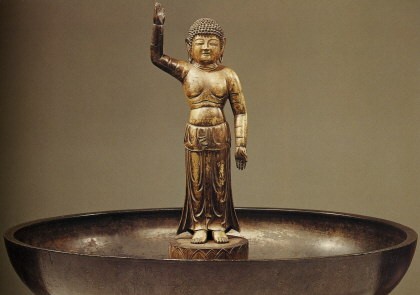Buddha Statues and Japan – June 2010
Monday, June 7th, 2010Hello Subscribers,
New statues and knowledge updates for June 2010.
BUDDHIST-ARTWORK.COM (June eStore)
- CALLIGRAPHY. Three new pieces. These extraordinary works are not copies — they are originals written with a big calligraphic brush. Once sold, they are no longer available. www.buddhist-artwork.com/html/artist-corner.html
- KUJAKU-MYO-O. The Peacock King. Two new pieces. Kujaku means peacock. Peacocks eat poisonous plants and snakes, which provide the nectar that ensures the peacock’s beauty. Revered from ancient times, Kujaku represents the overcoming of anger, greed, and other “poisons,” and symbolizes the elimination of karmic hindrances. www.buddhist-artwork.com/html/kujaku-myoo.html
- BISHAMONTEN. Two new products. Bishamon is the god of wealth and treasure, and protects the Buddhist law. He is one of Japan’s Seven Lucky Gods, but he is also worshipped independently of the group of seven. www.buddhist-artwork.com/statues-buddhism/bishamon-statues.html
———————————————————————————–
A-to-Z Photo Dictionary of Japanese Buddhism
- SHŌKI 鍾馗 – THE DEMON QUELLER
www.onmarkproductions.com/html/shoki.shtml
Added photos and revised text. Shōki’s popularity peaked in Japan during the Edo period (1615-1868), when people began to hang images of Shōki outside their houses to ward off evil spirits during the Boys’ Day festival (Tango no Sekku 端午の節句, May 5 each year, but now a festival for all children of both sexes) and to adorn the eaves and entrances of their homes with ceramic statues of the deity. Today, Shōki is a minor deity relatively neglected or forgotten by most Japanese, except perhaps in Kyoto city, where residents still adorn the eaves and rooftops of their homes with Shōki’s effigy to ward off evil and illness, and to protect the male heir to the family. - KANNON BOSATSU. GOD/GODDESS OF MERCY.
www.onmarkproductions.com/html/kannon.shtml
One of the most widely worshipped divinities in Asia and Japan in both ancient and modern times. This page catalogs over 100 forms of Kannon in Japan. It features nearly 130 photos, copious reference notes, spellings in multiple Asian languages, and a handy A-to-Z List of Kannon Forms. The Kannon Notebook is an ongoing project aimed at scholars, art historians, practitioners, and laity alike. Presented on one page for easy printout. - MUROMACHI ERA STATUARY (1392-1568).
www.onmarkproductions.com/html/busshi-buddha-sculptors-muromachi-era-japan.html
The new and reformed Buddhist sects of the prior Kamakura period consolidated their gains, and Buddhism for the commoner thereafter remained a regular feature of Japan’s religious landscape. Pilgrimages to sacred sites devoted to Kannon Bosatsu, to the Ise Shinto shrines, and to the top of Mt. Fuji also became popular. Buddhist statuary, however, along with the power of the Buddhist monestaries, plummeted. - KAPPA REVISITED.
www.onmarkproductions.com/html/kappa.shtml
Updated with new photos and text. The Kappa are incredibly strong river imps. They attack horses, cattle, and humans, usually dragging their prey into the water, where,
according to various legends, they feed on their blood, drain their life force, or pull their anuses out through their livers, sucking their entrails, leaving nothing behind except a hollow gourd. Yet, the Kappan can be benevolent — they are supposedly skilled teachers in the art of bone setting and other medical skills.
END.
sincerely and gassho
mark schumacher







